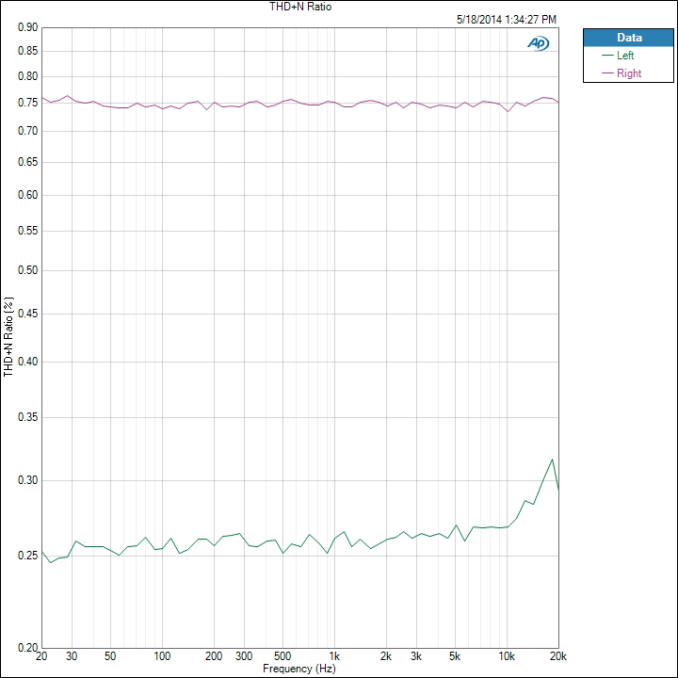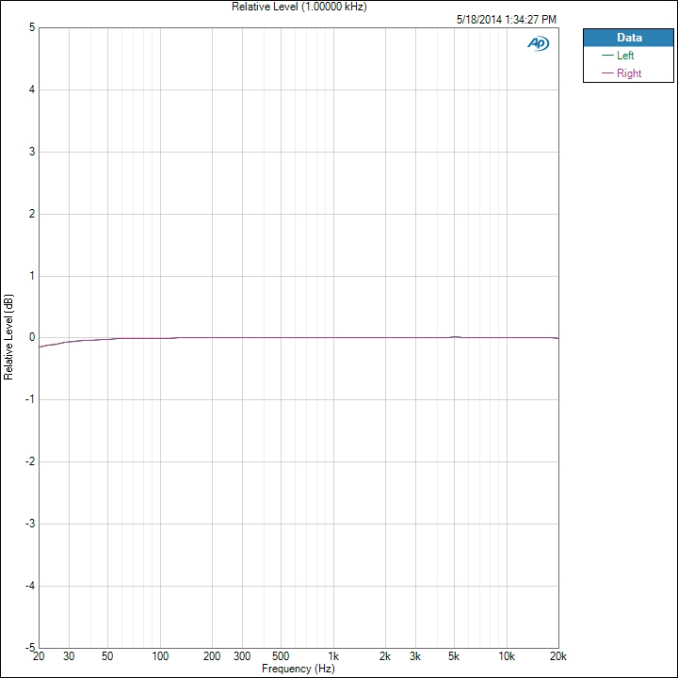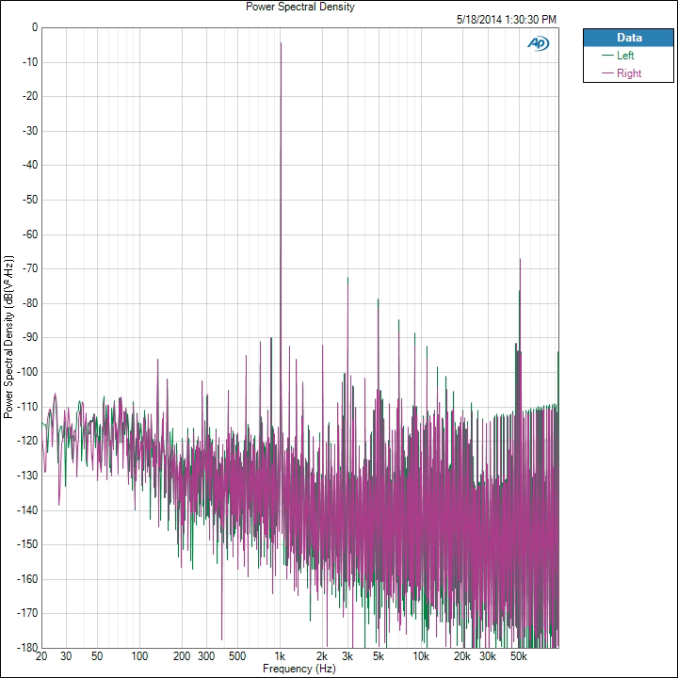Smartphone Audio Testing - HTC One M8 and Samsung Galaxy S5
by Chris Heinonen on June 2, 2014 8:00 PM EST- Posted in
- Smartphones
- Mobile
- Testing
- Audio Precision
Samsung Galaxy S5 Audio Testing
Compared to the HTC One M8, the Samsung Galaxy S5 has a worse audio system. It only puts out around 20% of the wattage of the HTC One M8, making it less likely to be able to drive every headphone to a reasonable level. The THD+N on the 15 Ohm load is lower with the Samsung, but it is putting out half the power and under a quarter of the watts of the HTC One M8. If you drop the HTC One M8 down a single volume level it will still be far more powerful but likely have lower THD+N.
Dynamic Range is almost identical between the two phones, and close enough that you will not hear a difference. Crosstalk is a major difference as the Samsung is -20 dB worse here than the HTC One M8. You are likely to hear sound from one channel in the other ear. This can reduce the size of the stereo image and present the music as being more unfocused.
The relative level is better on the Samsung but I don’t think anyone will be able to hear the difference between the two.
| 15 Ohm | 33 Ohm | 150 Ohm | 330 Ohm | |
| Dynamic Range | 91.877 dB | 91.921 dB | 92.113 dB | 91.985 dB |
| THD+N | 0.1457% | 0.0505% | 0.0102% | 0.0103% |
| Crosstalk (L) | -38.347 dB | -44.767 dB | -57.666 dB | -64.503 dB |
| Crosstalk (R) | -38.329 dB | -44.804 dB | -57.704 dB | -64.485 dB |
| Output Power | 22.31 mW | 10.63 mW | 2.602 mW | 1.194 mW |
| Output Voltage | 577.3 mVrms | 592.4 mVrms | 624.7 mVrms | 627.8 mVrms |
| Relative Level (20Hz - 20kHz) | ±0.081 dB | ±0.081 dB | ±0.082 dB | ±0.082 dB |
Compared to the HTC, the THD+N on the S5 is much higher. Whereas the HTC only passes 0.2% around 20kHz, the S5 is past 0.25% for the entire time on the stepped frequency sweep. The Right channel shows higher THD+N values than the left channel, while the HTC is identical in both channels. I checked the graph for every impedance load and they all look identical to this so it isn’t an error in measurement.
Unlike the HTC, the frequency response of the Galaxy S 5 is flat out to 20kHz. It has the same meaningless drop at 20Hz as well. Again I don’t think anyone will hear the difference, but the Samsung is better.
This chart shows that the S5 favors odd-order distortion over even-order distortion. The 2nd and 4th harmonics are below -90dB and -100dB respectively, while the 3rd and 5th order harmonics are each over 20dB higher. Most people find odd-order distortion harsher than even-order distortion.
Conclusions
Unlike the HTC One M8, there are no sound modes to play around with in the Galaxy S 5. With these two flagship phones for 2014, the HTC One M8 is packing the superior audio system. Is has a more powerful amplifier at all levels, lower crosstalk, and lower THD+N. The relative frequency response is worse but not by an audible amount.
The HTC One M8 will be more versatile by supporting a wider selection of headphones at more listening levels. There will be headphones that the Samsung is not able to drive to reasonable listening levels that the HTC One M8 will have no issues with.













78 Comments
View All Comments
bigboxes - Tuesday, June 3, 2014 - link
I never use the headphone out. I use Bluetooth to connect my Note 3 to my Alpine and the sound is great. The only issue I noticed is an occasional tick in the sound which I assume is when I receive data (texts, e-mails, etc.). Not sure how to eliminate that. If anyone has a suggestion, please let me know.The1Metallian - Tuesday, June 3, 2014 - link
@bigboxes I never have any noise due to notifications. I use a sound profile manager so when I start the music I choose the profile that has notifications muted, media almost all the way up, phone half way up (for emergencies!).I must add that the poor quality is more evident depending on the type of music being played. When the music is mostly guitars, bass, drums and vocals (metal) I don't notice it, but if keyboards come up front then it sounds kinda garbled. The same with sustained cymbals.
You have a Note 3. That device is newer than the GS3. Maybe it has better bluetooth?
bigboxes - Wednesday, June 4, 2014 - link
Probably. However, I came from an HTC 4G EVO LTE. The Bluetooth on that model sucked. I RMA'd a Jawbone headset thinking it was bad. When I got the Note 3 I realized it was just the HTC handset and not the Jawbone. It could be the Bluetooth or it could be the antennas or both. I'm not AnandTech where I have labs and access to different equipment. I can tell you that the audio over Bluetooth sounds amazing. Of course, the Alpine could have something to do with that. :)Jimster480 - Tuesday, June 10, 2014 - link
I had an EVO 4G LTE and I never had any issues with the bluetooth! My father has one too and his bluetooth never acts up. it could have been your phone specifically!cheinonen - Tuesday, June 3, 2014 - link
Bluetooth testing is something I plan to add in the future. I need to decide what I want do with it, but likely something similar to this. There is also a legibility test for talking that can be done over Bluetooth which will be interesting to see. Hopefully Bluetooth doesn't have issues with USB control as analog does, but I will test both ways to be sure.Jimster480 - Tuesday, June 10, 2014 - link
I think that the sound via bluetooth would depend on the DAC of the device on the receiving side? I'm pretty sure bluetooth is a digital signal and therefore the receiving device would have to convert it.haukionkannel - Tuesday, June 3, 2014 - link
Interesting!It would be nice to see some pro portable flack player compared to these phones.
What is the best audio phone and are they even near or a far, far away distance compared to high class portable audio players or real hifi DACs?
cheinonen - Tuesday, June 3, 2014 - link
If you want comparisons to some really high end gear, I've been testing the Auralic Vega DAC ($3,500) and the Auralic Taurus headphone amplifier ($1,900). Since the headphone output here is a combination of a DAC and headphone amp, these numbers aren't exactly comparable.The Vega has 0.000345% THD+N, a frequency deviation of 0.002 dB, Dynamic Range of 125 dB, and Crosstalk of -130 dB.
The Taurus does over 5V into 15 Ohm, and nearly 20V into 33 Ohm, 150 Ohm, and 330 Ohm. It has 0.0004% THD+N, deviation of 0.007dB, 124 dB of Dynamic Range, and -70 dB of Crosstalk. IMD, which isn't measured on the phones, is also below -100 dB at maximum gain.
haukionkannel - Thursday, June 5, 2014 - link
Thanks to this info! But the comparison to real portable devices would be more important. I am in situation where normal phone does not produce good enough sound compared separate mobile music player. I am just wondering if we are getting near the situation where phone is good enough compared to dedicate high-end mobile music player?cheinonen - Thursday, June 5, 2014 - link
I don't really use any portable DACs and amps, either for work or for my daily life. If I get my hands on one I will measure it, but it's an area I don't really venture into.